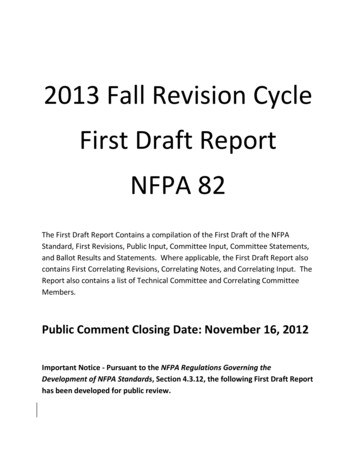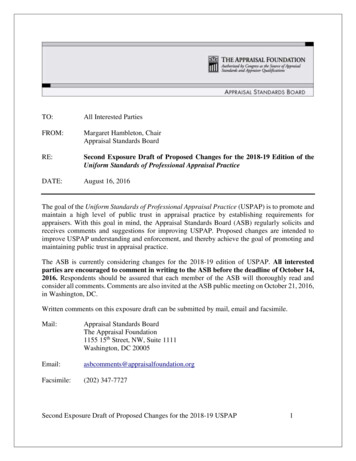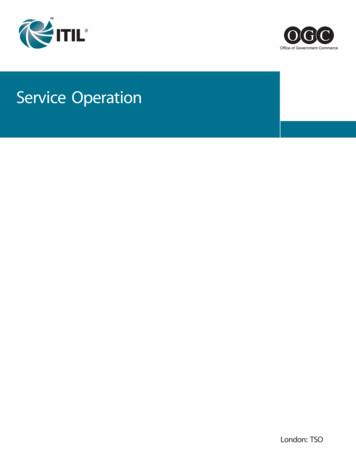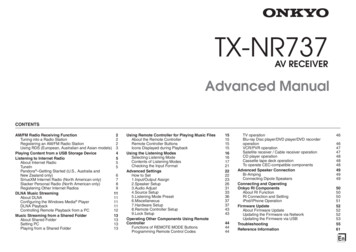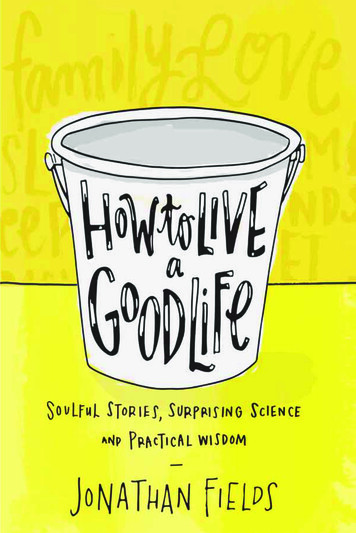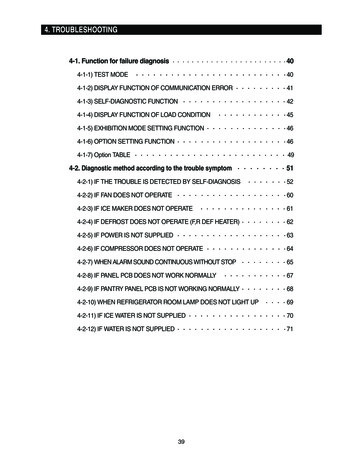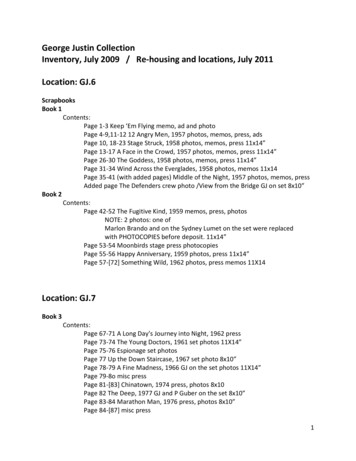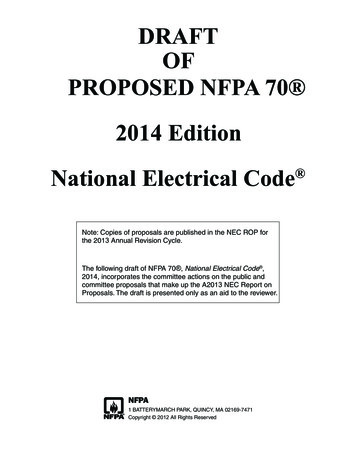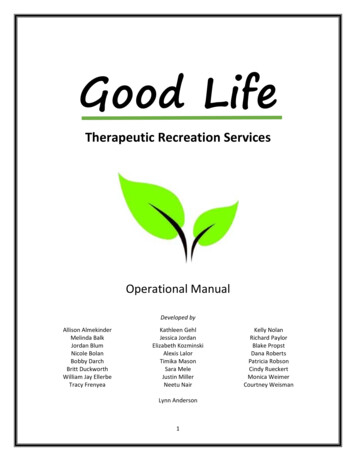
Transcription
Good LifeTherapeutic Recreation ServicesOperational ManualDeveloped byAllison AlmekinderMelinda BalkJordan BlumNicole BolanBobby DarchBritt DuckworthWilliam Jay EllerbeTracy FrenyeaKathleen GehlJessica JordanElizabeth KozminskiAlexis LalorTimika MasonSara MeleJustin MillerNeetu NairLynn Anderson1Kelly NolanRichard PaylorBlake PropstDana RobertsPatricia RobsonCindy RueckertMonica WeimerCourtney Weisman
Table of ContentsIntroduction and GoalsPageIntroduction and BackgroundNeeds AssessmentTheory Base and Guiding PrinciplesPurpose, Goals, and OutcomesImpact Statement33456Specific Program/Service Protocols:Good Life TR Services Referral ProtocolOutdoor Recreation RX Referral ProtocolGetting to Know You: Good Life Assessment and Plan ProtocolMind & Body Well‐Being Group ProtocolMove It! Movement Group ProtocolLeisure Adventure! Leisure Education ProtocolOut & About Reignite Your Life Community Inclusion ProtocolWhat Leisure Leads To Transitions Protocol915212734415264Comprehensive Evaluation PlanEvaluation Plan70Human Resources/PersonnelStaffing and CredentialsJob DescriptionsVolunteers and Interns787980Budget/Resource NeedsBudget with justification82Finance/RevenuePricingFunding Sources8687Risk ManagementRisk Management and SafetyForms8992Marketing and Public RelationsMarketing PlanMarketing Tools116118Organizational Structure and RequirementsOrganizational Structure, Board, and Other Legal Requirements126Appendix A ‐Fact SheetsLaws and regulations that apply to Good Life Therapeutic Recreation ServicesAppendix B ‐ Attachments for Mind and Body Group2130151
Introduction and GoalsWritten by Courtney Weisman, Tracy Frenyea, and Kimberlin Britt DuckworthIntroduction and BackgroundGood Life Therapeutic Recreation Services is a private practice with programs designed to meet the needs ofparticipants by improving leisure well‐being and cultivating a flourishing life. Leisure involvement is an important aspectof health, wellness, and quality of life (Stumbo & Peterson, 2013). Services are provided to participants with a widerange of needs and differences across the lifespan. The needs of our participants are discovered through referrals,assessments, and evaluations. Good Life Therapeutic Recreation Services is an evidence and strengths‐based practice,providing strengths‐based services seeking participants through traditional, as well as, park and play prescriptionreferrals. Strengths‐based services emphasize the individual’s strengths and capacities, as opposed to a deficits‐basedparadigm, which focuses on the medical model’s perspective of disability and illness (Heyne & Anderson, 2012).Participants are able to utilize our services after a thorough evaluation and assessment of his/her individual needs.Good Life Therapeutic Recreation Services programming focuses on well‐being, movement, community inclusion, leisureeducation, and transition/discharge, all of which can be modified and refined to better serve the individual.In addition, we have designed comprehensive plans for evaluation, budgeting, financing, risk management, marketing,organizational structure, and other requirements.Needs AssessmentTherapeutic recreation services have much to offer individuals in developing their leisure lifestyle and improving theirpsychological, physical, and social well‐being (Stumbo & Peterson, 2013). In 350 B.C.E. Aristotle wrote “If, then, there issome end of the things we do, which we desire for its own sake (everything else being desired for the sake of this), and ifwe do not choose everything for the sake of something else clearly this must be the good and the chief good. Will notthe knowledge of it, then, have a great influence on life?” (p. 1). We have taken this to mean that individuals acrosstheir lifespan deserve a good life and this “good life” must include leisure well‐being. Attaining leisure well‐being and aflourishing life include developing or refining skills in community inclusion, leisure education, and movement programs.Therapeutic Recreation Specialists at Good Life Therapeutic Recreation Services have created a plan to provide servicesto help participants build their strengths in the following areas: Improved stress managementCommunity inclusionTransitioning through different phases of lifeExercise promotionAdaptive equipment and modificationsEducation of leisure, barriers, and availableresourcesFinancial aid Knowledge and awareness of leisure opportunitiesDecreased symptoms of depression and anxietyDecrease in use of psychotropic medicationsImproved memoryImproved communication with peers and circle ofsupportImproved intrinsic motivationThese are some of the areas that will be strengthened to ensure that Good Life provides the highest quality of servicesfor each participant. By focusing on these areas, our practice will enable participants to achieve a flourishing life, as wellas leisure well‐being.3
Theory Base and Guiding PrinciplesGood Life Therapeutic Recreation Services is founded upon several theoretical frameworks. The information belowexplains the theoretical frameworks and principles contributing to the foundation of Good Life Therapeutic RecreationServices. The chosen theories for this project are derived from positive psychology and the strengths based approach,which is further outlined within the guiding principles section.Broaden‐and‐Build Theory of Positive EmotionsDr. Barbara Fredrickson is the developer of the Broaden‐and‐Build Theory of Positive Emotions. The Broaden‐and‐Build Theory of Positive Emotions was established to emphasize the importance of positive emotions (Anderson &Heyne, 2012). The essence of the Broaden‐and‐Build Theory of Positive Emotions is that positive emotions “broaden”our lives cognitively, emotionally, and socially, and consequently positive emotions develop or “build” these benefits(Anderson & Heyne, 2012; Heyne & Anderson, 2012). In accordance with this theory, “positive emotions expandcognition and behavioral tendencies” (Anderson & Heyne, 2012, p.100). The overarching concept of this theory is thateven though emotions fluctuate, positive emotions have long lasting inherent value with numerous benefits for ourlives.Leisure Coping TheoryThe Leisure Coping Theory states that leisure may be utilized as a means of managing internal and externalchallenges and enabling the cultivation of positive resources (Anderson & Heyne, 2012; Heyne & Anderson, 2012).Lazarus and Folkman (1984) define coping as, “constantly changing cognitive and behavioral efforts to manage specificexternal and/or internal demands that are appraised as taxing or exceeding the resources of the person” (p.41 as citedin Anderson & Heyne, 2012, p.116). Because Good Life Therapeutic Recreation Services focuses on enhancing well‐beingand health through therapeutic recreation, providing clients with positive resources through leisure will enable effectivecoping as outlined through the Leisure Coping Theory. Further, leisure as coping is empirically supported as Hutchinson,Bland, and Kleiber wrote, “ a person‐centered approach to designing and delivering leisure‐based coping interventionsis warranted” (p.16).Self‐Determination TheorySelf‐Determination accounts for when an individual feels in control of his/her life, which has numerous benefitsrelative to, “sense of motivation, competency, and autonomy” (Anderson & Heyne, 2012b, p.118). Gaining awareness ofour, “values, beliefs, and preferences enables us to participate more fully in life, including leisure ” (Anderson &Heyne, 2012b, p.118). Further, motivation related to healthcare behavior change has been linked to autonomy or beingself‐determined (Williams, 2002). Self‐Determination Theory encompasses both extrinsic and intrinsic motivation withthe most self‐determined form of motivation being intrinsic motivation (Deci & Ryan, 2000). Self‐Determination Theoryhas been commonly applied to recreation research (Hill & Sibthorp, 2006).Guiding Principles“Leisure participation for the purpose of well‐being is at the heart of the profession of therapeutic recreation” accordingto Anderson and Heyne (2013, p.119). Thus Good Life Therapeutic Recreation Services has several guiding principles,stemming from the theoretical frameworks described above as well as models, which relate to well‐being in therapeuticrecreation, which impact our service protocols and ideals.One such model, the Leisure and Well‐Being Model (LWB) focuses on “cultivation and expression of one’s full potentialincluding strengths, capacities and assets” (Carruthers & Hood, 2007, p.280 as cited in Hood & Carruthers, 2016, p.104).The Flourishing through Leisure Model pushes forward the LWB, through specifically focusing on utilizing leisure pursuitsas a means of building upon inherent strengths through positive experiences (Anderson & Heyne, 2016). This model is4
of importance to the guiding principles of Good Life Therapeutic Recreation because it is grounded in a social orecological model of understanding the disability experience (Anderson & Heyne, 2012a). Individuals shall be perceived holistically as unique individuals to be treated with dignity and respect.All clients will receive therapeutic interventions within the scope of the strengths‐based approach.All assessments will be done through a strengths‐based approach hence searching for, “the dreams, goals, andstrengths in participants and the environments in which they live, work, and play” (Anderson & Heyne, 2013,p.91).Treatments will be client‐centered (Anderson & Heyne, 2012a) while promoting shared decision‐making.All employees, volunteers, and interns will prescribe to a transdisciplinary team approach in order to moreeffectively enhance client treatment outcomes.Disability will be perceived through the biopsychosocial model and the International Classification of Functioning(ICF) as outlined by the World Health Organization.The definition of well‐being as defined by Carruthers and Hood (2007) as, “a state of successful, satisfying, andproductive engagement with one’s life and the realization of one’s full physical, cognitive, and social‐emotionalpotential” (p. 280) will guide staff, volunteers, and interns to promote well‐being for clients and his/her selves.All staff, volunteers, and interns, as per the Flourishing through Leisure Model, will understand and promotethat leisure will be treated as a, “strength in and of itself and a context to build other strengths” (Anderson &Heyne, 2016, p.120).PurposeThe drive behind Good Life Therapeutic Recreation Services comes from our desire to create a space that is inclusive,safe, and effective where an individual can achieve his or her goals, dreams, and aspirations. We are here to assistparticipants in developing physical, psychological, social, spiritual, and cognitive strengths through movement, well‐being practices, community inclusion, and leisure education. We are committed to helping participants improve thequality of their lives through the therapeutic application of recreation and leisure pursuits by taking a whole‐person,strengths‐based approach.Goals To provide therapeutic recreation services in the following areas: mind/body practices, physical activity,community inclusion, and leisure education.To provide evidence‐based services based on a foundation of continual improvement through ongoingevaluation.To provide strengths‐based therapeutic recreation services through assessment, planning, implementation, andevaluation practices.To seek out and encourage collaborations across our community to better serve our participants throughinclusive practices.To improve the quality of life and well‐being for all our participants, ensuring an atmosphere that is inclusive toall.To assist participants in identifying and achieving autonomy, self‐efficacy, self‐determination, and self‐advocacythrough theory based and therapeutic interventions.To help participants recognize and further develop their personal strengths through recreation and leisure.To develop and enhance participant’s skills in community engagement.To encourage autonomous and confident utilization of community recreation and leisure opportunities toenhance community inclusion.To educate participants on the benefits of recreation and leisure.To promote an appreciation for the fundamental rights of all individuals to enjoy recreation and leisure pursuits.5
OutcomesThrough participation in Good Life Therapeutic Recreation Services: Participants will show improvement in well‐being on measures of physical health.Participants will show improvement in well‐being on measures of psychological/emotional health.Participants will show improvement in well‐being on measures of cognitive health.Participants will show improvement in well‐being on measures of social skill attainment.Participants will show improvement in well‐being on measures of spiritual health.Participants will recognize benefits of recreation and leisure pursuits on their quality of life.Participants will demonstrate the ability to autonomously utilize community recreation and leisureopportunities.Participants will be able to identify and appreciate their personal strengths.Vision, Mission and ValuesVision“Flourish across your lifespan – enjoy a good life through recreation and leisure.”MissionOur mission is to ensure quality recreation and leisure experiences, optimizing your well‐being and improving the qualityof your life through safe, effective and goal oriented practices.ValuesAt Good Life Therapeutic Recreation Services we value: AdvocacyAn ecological approach to helping participantsCollaboration across and throughout ourcommunityCommunity resourcesCreativity in our workEfficacy in our practicesInclusivityIntegral worth in leisure participationIntrinsic motivationPrivacy and confidentiality for our participantsQuality in our workQuality of life for allRecreation and leisure appreciationSelf‐efficacy inherent in our participantsTaking a strengths‐based approach to our workWell‐being in all its forms and nuances6
Program Impact StatementParticipants at Good Life Therapeutic Recreation Services will have the opportunity to engage in programming that isindividualized and goal oriented. Taking part in mind and body, movement, cognitive enhancement, and communityinclusion programming will lead to positive outcomes in the lives of participants including good physical health, reducedstress, lifelong recreation and leisure skills, improved cognitive functioning, autonomy in using community recreationresources, improved quality of life and overall well‐being. Post‐transition from services, participants will be enabled tocontinue appreciating and using skills learned while under our care, leading a self‐determined leisure lifestyle.References for IntroductionAnderson, L. S., & Heyne, L. A. (2012a). Flourishing through leisure: An ecological extension of the leisure and well‐beingmodel in therapeutic recreation strengths‐based practice. Therapeutic Recreation Journal, 46(2), 129‐152.Anderson, L. & Heyne, L. (2012b). Therapeutic Recreation Practice: A Strengths Approach. Venture Publishing, Inc.: StateCollege, PA.Anderson, L., & Heyne, L. (2013). A strengths approach to assessment in therapeutic recreation: Tools for positivechange. Therapeutic Recreation Journal, 47(2).Anderson, L. & Heyne, L. (2016). Flourishing through leisure and the upward spiral theory of lifestyle change.Therapeutic Recreation Journal, 50(2), 118‐137.Aristotle (2001). Nicomachean ethics (W. D. Ross, Trans.) [electronic resource]. Blacksburg, VA : Virginia Tech, 2001.(Original work published 350 B.C.E.)Carruthers, C., & Hood, C. (2007). Building a life of meaning through therapeutic recreation: The leisure and well‐beingmodel, part I. Therapeutic Recreation Journal, 41(4).Deci, E., & Ryan, R. (2002). Handbook of Self‐ Determination Research. Rochester, NY: University of Rochester Press.Heyne, L., & Anderson, L. (2012). Theories that support strengths‐based practice in therapeutic recreation. TherapeuticRecreation Journal, 46(2).Hill, E. & Sibthorp, J. (2006). Autonomy support at diabetes camp: A self‐ determination theory approach to therapeuticrecreation. Therapeutic Recreation Journal 40(2), 107‐125.Hood, C., & Carruthers, C. (2016). Supporting the development of a strengths‐based narrative: Applying the leisure andwell‐being model in outpatient mental health services. Therapeutic Recreation Journal, 50(2).Hutchinson, S.L., Bland, A.D., & Kleiber, D.A. (2008). Leisure and stress‐coping: implications for therapeutic recreationpractice. Therapeutic Recreation Journal, 42(1), 9‐23.Stumbo, N. J., & Peterson, C. A. (2009). Therapeutic Recreation Program Design: Principles and Procedures (5th ed.). SanFrancisco, CA: Pearson Education.Williams, G. (2002). Improving patients' health through supporting the autonomy of patients and providers. In E. Deci &R. Ryan (Eds), Handbook of Self‐Determination Research (pp. 335‐351). Rochester, NY: The University ofRochester Press.7
Good Life Therapeutic Recreation Services:Specific Program/Service Protocols8
TitleGood Life Therapeutic Recreation Services Referral and Intake FormBrief Description of TR Service/ProgramA comprehensive referral and intake form that can be used as a self‐referral or as a referral from parents/guardians,physicians, health care professionals or other professional sources.Research on Efficacy/Literature Review SummaryThe American Therapeutic Recreation Association (ATRA) defines a referral as “a request or recommendationto initiate services, including an evaluation of the patient/client and interventions determined to be necessary orbeneficial to reach planned outcomes” (ATRA, 2015). A referral to therapeutic recreation (TR) services may be madeon behalf of an individual or a person may self‐refer for services; being admitted for services in some settings mayalso constitute a referral on behalf of an individual (ATRA, 2015).The referral/intake process for Therapeutic Recreation services may seem like it is a trivial step, but in realityit is the first step toward achieving the participant’s goals, dreams and desires. A referral for TR services will helppractitioners identify the direction of treatment (Stumbo & Peterson, 2009). Often referrals by other professionals(e.g., psychiatrists, social workers, physicians) will specify diagnoses or conditions which need treatment; thesereferrals may also indicate what programs and interventions are desired by the professional (Stumbo & Peterson,2009).At times, allied professionals may make suggestions for treatment or programming which may beinappropriate; it is the responsibility of the therapeutic recreation specialist to educate these professionals about thespecific services that his or her agency offers to avoid miscommunication and misdirection (Stumbo & Peterson,2009). Further, Stumbo and Peterson (2009) encourage therapeutic recreation specialists to be realistic when areferral is made for a service that cannot be provided at their agency. It is suitable to make a referral to a moreappropriate setting when necessary.In keeping with best practices, a referral form should include the option to self‐refer, meaning that theparticipant has the chance to be an advocate for themselves. Self‐advocacy is the ability to speak up for one’s wantsand needs and it has been said that self‐advocacy is an essential skill to live the best life possible (Stuntzner & Hartley,2015). Self‐advocacy can yield many benefits, including positively altering one’s view of themselves and alsodeveloping leadership capabilities (Ryan & Griffiths, 2015). These benefits have been proven through research donewith individuals with mental illness (Pickett et al., 2012) and individuals with intellectual disabilities (Feldman, Owen,Andrews, Hamelin, Barber, & Griffiths, 2012). In both studies, the groups received either self‐advocacy/empowermenttraining (Pickett et al., 2012) or self‐advocacy training with a focus on rights and responsibilities in relationto healthcare (Feldman, Owen, Andrews, Hamelin, Barber, & Griffiths, 2012). The results for both studies indicatedthat those groups that received the specialized training were better able to advocate for themselves, had higher self‐esteem (Pickett et al., 2012) and were more knowledgeable when it came to answering healthcare related questions,indicating that they would be advocates for themselves in a healthcare or other type of setting (Feldman, Owen,Andrews, Hamelin, Barber, & Griffiths, 2012). These are all important outcomes and reasons that show that thereshould be more opportunities for self‐advocacy provided to all individuals, but in particular to those of differentabilities since they usually face the most barriers to self‐advocacy (Stuntzner & Hartley, 2015).Referral CriteriaIndividuals may self‐refer. Referrals may also come from parents/guardians and professional sources such asphysicians, health care providers (e.g. nursing, PT, OT), school administrators and recreation agencies (e.g. YM/WCA).Goals Provide initial referral to TR servicesGather preliminary reason for referralDetermine if practice is appropriate referral9
Measurable Objectives The number of total referrals received will be counted, when the referral/intake process is reviewed.The different sources of referral (self, professional, etc.) will be quantified and documented, when thereferral/intake process is reviewed.In order to determine appropriateness of services offered, the different concerns marked on the referralform will be quantified, when the referral/intake process is reviewed.The number of participant referrals that we cannot accommodate based on services needed will becounted, when the referral/intake process is reviewed.Time RequiredCompletion of the referral/intake form should take approximately 5 minutes when completed with paper/pencil.Materials, Equipment, and Resources Needed Paper copiesClipboardPensActivitiesWhen an individual requests services from our private practice, the referral form will be provided via email or inperson. A representative will be available in person or over the phone to answer questions and to assist with thecompletion of the referral form if necessary.MethodsWe will collaborate with allied health professionals to inform them of our services and provide them with an initialsupply of forms (which can be duplicated) along with information on when, why and how they would refer to ourservices. This collaboration will take place with many different settings within the community that may make referralsincluding: Acute care hospitals Free standing rehabilitation hospitals Rehabilitation from units in acute care hospitals Long‐term care facilities or skilled nursing facilities Comprehensive outpatient facilities Inpatient and outpatient mental, behavioral health/psychiatric facilities Addiction/substance abuse rehabilitation facilities Home health care agencies Residential facilities for persons with disabilities Adult day care centers Centers for independent living Public and private school systems Non‐profit disability related/recreational agenciesMethods for completing the referral form include*: completing the referral in person while in the office receiving, completing, and submitting via mail (US Postal System/Service) or emailOnce the referral for recreational therapy is made, an assessment will be completed by the TRS.Our practice will refer individuals to other more appropriate settings/agencies/organizations when appropriate.*Eventually, we anticipate creating an online web‐based referral form in addition to having the form available on aniPad for individuals to submit electronically.10
Leadership VariationsIt is anticipated that an adult will be completing the referral form, especially if the participant is under the age of 18.If vision is diminished, there is a language barrier or some other difference in ability, the referral form may be read tothe participant and completed by a proxy representative.Expected Outcomes and ContraindicationsExpected outcomes include providing quality therapeutic recreation services using best practices for each participant.Also, it is expected that the referral process will increase efficacy and efficiency of services and decreaseimproper/ineffective services being provided.Contraindications could include confusion on the part of the person filling out the form (participant themselves orother referring source) when determining the needs/concerns. This can be rectified by the Assessment and PlanProtocol.DocumentationThe referral/intake form asks for the following demographic information: Name Address and contact information (phone, email) Family contact in case of emergency and applicable phone number Relation to individual requesting services (if not completed by participant) Legal guardian if participant is under 18 years of age (including address of guardian) Referring person and agency contact information if applicable Self‐referral indicator check box Prescribing physician, diagnosis, contact information, and physician's order for TR (if applicable) Insurance information for billing purposesThe back side of the form has many indicators where interested participants can select areas or interest or need(interventions) covering the following areas: Cognitive Concerns Community Inclusion Physical Concerns Psychosocial Concerns Aquatic Therapy InterestsThe form concludes by providing a free‐write area asking if the interested participant would like to share anyadditional concerns or issues they would like to address. This area will help with evaluation of the referral/intakeform ‐ to include modifications if necessary.Individuals completing the form are advised that if they are not completing the form in person, that a representativewill contact them in three business days to schedule an appointment.The referral form will be continuously monitored. Requests for services will be tracked in a spreadsheet to keep atally of each type of request. Requests for services that are not normally provided will also be tracked in aspreadsheet to consider for inclusion into practice, if practical. Requests resulting in referrals to otheragencies/organizations will be tallied in the spreadsheet. Based on these outgoing referrals, TRS will considerimplications of possible collaborations.Evaluation PlanReferral/Intake forms will be reviewed for completeness and understanding. The TRS tasked with formativeevaluation of the referral protocol will monitor the referral/intake forms on a regular basis (as they are received) todetermine if any updates/changes or deletions are required. The request checkboxes will be monitored for possible11
interventions to be included in practice. Referrals to other agencies will also be formatively evaluated to determine ifthere are opportunities for collaboration or inclusion in our practice.Staff Qualified to Deliver ServiceNo specific training is required to provide the Referral/Intake form, except for staff to be familiar with the items onthe form, in the case of questions. All representatives in the practice at any level, however, will have receivedDisability Awareness Training as a general overview of being able to work with individuals of different abilities. Theform should be reviewed by professional familiar with services provided.Safety/Risk Management/PrecautionsNo safety issues are present.AttachmentsAttached please find the Therapeutic Recreation Services Referral/Intake FormReference ListAmerican Therapeutic Recreation Association (2003). Recreational therapy treatment orders. Retrieved fromwww.healthpronet.org/ahp month/07 04.html.American Therapeutic Recreation Association (2004). The recreational therapy professional. Retrieved fromwww.healthpronet.org/ahp month/07 04.html.American Therapeutic Recreation Association. (2015). Standards for the practice of recreational therapy & self‐assessment guide. Hattiesburg, MS: The Association.Brainworksrehab.com (n.d.). Referrals. Retrieved from http://www.brainworksrehab.com/referrals/.Feldman, M.A., Owen, F., Andrews, A., Hamelin, J., Barber, R., & Griffiths, D. (2012). Health self‐advocacy training forpersons with intellectual disabilities. Journal of Intellectual Disability Research, 56(11), 1110‐1121.Picket, S., Diehl, S., Steigman, P., Prater, J., Fox, A., Shipley, P., Cook, J. (2012). Consumer empowerment and self‐advocacy outcomes in a randomized study of peer‐led education. Community Mental Health Journal, 48(4),420‐430.Ryan, T.G., & Griffiths, S. (2015). Self‐Advocacy and its impacts for adults with developmentaldisabilities. Australian Journal of Adult Learning, 55(1), 31‐53.Striverectherapy.com (n.d). Strive recreational therapy – how it works. Retrieved o/how‐it‐works‐2/.Stumbo, N. J., & Peterson, C. A. (2009). Therapeutic recreation program design: Principles and procedures.San Francisco, Calif: Pearson/Benjamin‐Cummings.Stuntzner, S., & Hartley, M.T. (2015). Balancing self‐compassion with self‐advocacy: A new approach for persons withdisabilities. Annals of Psychotherapy & Integrative Health, 12‐28.Wagner‐Heffner, D. (n.d.). Recreation therapy referral form. Retrieved April 28, 2016from www.hcrt.net/index.php/referrals.Protocol AuthorsTracy Frenyea, Sara Mele, Jay Ellerbe12
13
14
TitleOutdoor Recreation Rx Referral ProtocolBrief Description of TR Service/ProgramOutdoor Recreation Rx is a nontraditional referral source for XXX Recreation Therapy Services. This protocol cultivatesvaluable community partnerships, particularly with local health care providers (HCP’s). Health practitioners canprescribe recreation to patients who would benefit from participation. It is a combined effort to improve health andwellness at an individual and community level. The written prescription
Good Life Therapeutic Recreation Services is a private practice with programs designed to meet the needs of participants by improving leisure well‐being and cultivating a flourishing life. . potential” (p. 280) will guide staff, volunteers, and interns to promote well‐being for c
